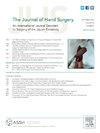Fractional Lengthening of Forearm Flexor Tendons: A Cadaveric Biomechanical Analysis
IF 2.1
2区 医学
Q2 ORTHOPEDICS
引用次数: 0
Abstract
Purpose
Multiple procedures have been described for wrist and finger flexion contractures and spasticity. Fractional lengthening of forearm flexor tendons involves making parallel transverse tenotomies at the musculotendinous junction to elongate the muscle. Currently, there is limited literature to define the biomechanical consequences of this lengthening technique.
Methods
Forty-eight flexor tendons were harvested from eight paired upper limbs including flexor carpi radialis, flexor carpi ulnaris, flexor pollicis longus, and flexor digitorum superficialis tendons. Each tendon that was lengthened was paired with the contralateral tendon as a control. A pair of transverse tenotomies were completed for the fractional lengthening. The first tenotomy was performed at the musculotendinous junction where the tendon narrowed to 75% of its maximal width. The second tenotomy was made 1 cm distal to the first. Tendon length was measured before and after fractional lengthening at a constant resting tension of 1 N. The maximum load at failure of each tendon and the mechanism of failure were each measured and compared with the contralateral side.
Results
After fractional lengthening, the mean increase in resting tendon length was 4 mm. When loaded to failure, the mean maximum load of fractionally lengthened tendons was 42% of the mean maximum load of intact tendons. All lengthened tendons failed at the distal tenotomy site.
Conclusions
Fractional lengthening resulted in an increase of 3–6 mm (mean: 4 mm) in tendon length at resting tension. There was a significant loss in tensile strength and load to failure following fractional lengthening compared with an intact musculotendinous unit.
Clinical relevance
The reduction in tensile strength following fractional lengthening results in loads at failure that are, in some cases, lower than the estimated forces required to perform basic tasks. Caution during the healing and rehabilitation period is warranted.
前臂屈肌腱的点阵延长:尸体生物力学分析。
目的:针对手腕和手指屈曲挛缩和痉挛,已有多种治疗方法。前臂屈肌腱点状延长术包括在肌肉肌腱交界处进行平行横向腱切开,以拉长肌肉。目前,确定这种延长技术的生物力学后果的文献有限:方法:从八对上肢采集了 48 条屈肌腱,包括桡侧屈肌腱、尺侧屈肌腱、拇长屈肌腱和趾浅屈肌腱。每条被延长的肌腱都与对侧肌腱配对作为对照。一对横向腱切开术完成了点状延长。第一个腱切开术在肌腱交界处进行,肌腱在该处变窄至最大宽度的 75%。第二次腱切开术在第一次腱切开术的远端 1 厘米处进行。在 1 牛的恒定静态张力下,测量了点状延长术前后的肌腱长度,分别测量了每条肌腱的最大失效负荷和失效机制,并与对侧进行比较:结果:部分延长后,肌腱静止长度平均增加了 4 毫米。加载至失效时,部分延长肌腱的平均最大载荷是完整肌腱平均最大载荷的 42%。所有延长的肌腱都在远端腱切开部位失效:结论:部分延长术使肌腱在静止张力下的长度增加了 3-6 毫米(平均:4 毫米)。与完整的肌腱单元相比,部分延长后肌腱的抗拉强度和失效载荷明显下降:临床意义:部分延长后拉伸强度降低,导致破坏时的负荷在某些情况下低于执行基本任务所需的估计力量。在愈合和康复期间应谨慎行事。
本文章由计算机程序翻译,如有差异,请以英文原文为准。
求助全文
约1分钟内获得全文
求助全文
来源期刊
CiteScore
3.20
自引率
10.50%
发文量
402
审稿时长
12 weeks
期刊介绍:
The Journal of Hand Surgery publishes original, peer-reviewed articles related to the pathophysiology, diagnosis, and treatment of diseases and conditions of the upper extremity; these include both clinical and basic science studies, along with case reports. Special features include Review Articles (including Current Concepts and The Hand Surgery Landscape), Reviews of Books and Media, and Letters to the Editor.

 求助内容:
求助内容: 应助结果提醒方式:
应助结果提醒方式:


